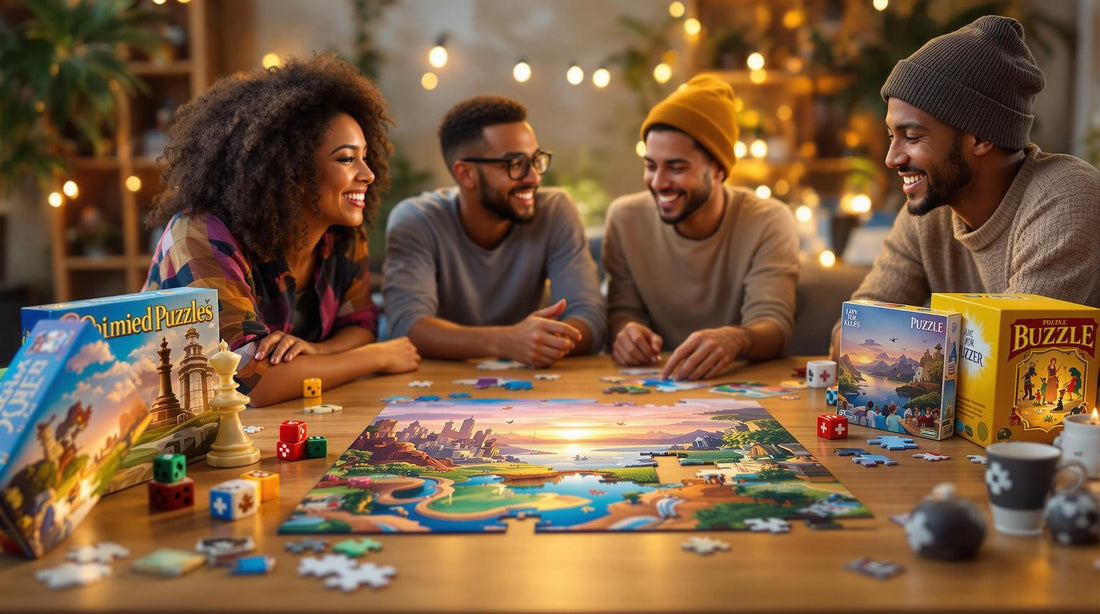Discover the Best Board Games for Every Player

How to Choose the Perfect Puzzle: A Beginner's Guide
Want to start puzzling but don’t know where to begin? Choosing the right puzzle is about finding one that matches your skill level, interests, and available space. Here’s a quick guide to get started:
- Piece Count: Start with 100-300 pieces for a manageable challenge.
- Puzzle Type: Jigsaw puzzles are great for beginners; logic puzzles and story-based options offer variety.
- Image Design: Pick themes you enjoy with clear color sections for easier sorting.
- Materials: Cardboard is affordable; wood offers durability but costs more.
- Tools & Features: Look for reference pictures, sorting trays, and anti-glare coatings to enhance your experience.
Pro Tip: Beginners who choose puzzles suited to their skill level are 73% more likely to stick with the hobby. Ready to dive in? Let’s explore the details!
10 Expert-Level Tips for Doing a Jigsaw Puzzle
Types of Puzzles
Jigsaw puzzles make up 67% of the puzzle market, making them a popular choice for beginners. Here’s how different puzzle types can align with your interests:
Jigsaw Puzzles
These classic puzzles are great for improving spatial reasoning and offer a gradual learning curve. Experts suggest starting with 100-300 piece puzzles with clear, distinct images. They strike a good balance between challenge and relaxation, making them perfect for those new to puzzling.
Logic Puzzles
From Sudoku to compact options like the 2x2 Rubik's Cube[6], logic puzzles focus entirely on mental challenges. They’re ideal for those who want a portable, space-saving way to engage their brain.
Story-Based Puzzles
For a more immersive experience, try options like Spin Master's Escape Room: The Game or Space Cowboys' Unlock! series. These puzzles often include hint systems to keep frustration at bay and are fantastic for group settings such as family game nights or social gatherings. Their adjustable difficulty ensures everyone stays engaged. This ties into the 'Single Player or Group' considerations discussed later.
How Hard Is This Puzzle?
The level of difficulty plays a big role in finding the right balance between your skills and the challenge at hand. Here's how to figure it out.
Number of Pieces
The number of pieces is a key factor in determining how challenging a puzzle will be. For adults who are just starting out, stick with puzzles that have 100-300 pieces. This range provides enough of a challenge without being overwhelming. Here's a quick guide:
| Age Group | Recommended Pieces | Best For |
|---|---|---|
| Adult Beginners | 100-300 | Learning techniques |
This approach helps maintain the balance between challenge and skill, as mentioned earlier. Once you feel more confident, you can gradually tackle puzzles with more pieces to keep things interesting.
Help and Hints
Difficulty isn't just about the number of pieces - it also depends on the tools and features available to assist you:
- Reference Pictures: A detailed image on the box can act as your roadmap.
- Piece Organization: Sorting trays allow you to group pieces by color or pattern, making assembly smoother.
- Edge Identification: Some puzzles, like Ceaco's "National Parks" series, have unique backing patterns for edge pieces, making it easier to start with the border.
Also, consider the image itself. Puzzles with clear, distinct color sections are easier to work on compared to those with large, uniform areas like skies. Pairing the right piece count with a well-chosen image can make all the difference.
sbb-itb-1ed942f
Build Quality and Materials
When choosing a puzzle, don’t just think about difficulty - how it’s made can make or break your experience. Even the best-designed puzzles can fall short if the materials are subpar.
Cardboard, Plastic, or Wood?
The material of a puzzle plays a big role in how durable it is and how it feels to handle. Here’s a quick breakdown of the most common options:
| Material | Advantages | Ideal For |
|---|---|---|
| Cardboard | Affordable | Beginners learning the ropes |
| Plastic | Long-lasting | Regular use or humid environments |
| Wood | High-end feel | Collectors or those seeking longevity |
If you’re new to puzzles and watching your budget, cardboard puzzles are a solid choice. Look for pieces that feel sturdy - good cardboard puzzles shouldn’t bend easily. On the other hand, wooden puzzles are built to last but come with a much higher price tag, often costing 3 to 5 times more than their cardboard counterparts.
Features That Make a Difference
Some extra features can elevate your puzzle experience. Keep an eye out for these quality markers:
- Textured, anti-glare coating for better visibility
- Snug-fitting pieces that stay in place
- Smooth edges without fraying
- Consistent thickness across all pieces
- Unique piece shapes that interlock securely
For added convenience, premium puzzles often include:
- Resealable bags to keep pieces sorted
- High-quality reference posters
- Durable boxes that won’t crush easily
Brands that offer replacement pieces and organizational tools like sorting trays can be a lifesaver, especially for beginners still refining their puzzle skills. These thoughtful extras also tie into storage solutions, which we’ll dive into next.
Match Your Style and Needs
The quality of a puzzle’s material won’t matter much if it doesn’t bring you joy. Let’s focus on finding puzzles that align with your interests and personality. Beginners often find it easier to complete puzzles that match their hobbies or favorite themes.
Pictures and Designs
Just like choosing the right piece count, picking a theme you love can make a big difference. For example, animal enthusiasts tend to finish wildlife-themed puzzles 40% faster than abstract ones. Want something a bit more fun? Try glow-in-the-dark puzzles or those with app features for an interactive twist.
Solo or Group Play
Your puzzle choice should fit how you plan to enjoy it. If you’re puzzling solo, a 300-piece puzzle can provide a satisfying challenge without being too much. It’s the perfect way to unwind and fully enjoy the process at your own pace.
For group puzzling, look for puzzles with:
- Distinct sections so everyone can work simultaneously
- Clear color zones to make sorting easier
- Plenty of space to accommodate multiple people
Space and Storage
Running low on space? Here are a few smart solutions:
- Roll-up puzzle mats: Great for saving your progress without taking up permanent space.
- Mini puzzles (6-8"): Perfect for small living spaces.
- Vertical puzzles: Double as wall art once completed.
These ideas not only save space but also work well with the durable materials we talked about earlier.
Where to Buy Puzzles
After thinking about storage needs and personal preferences, the next step is finding the best place to buy your puzzles. The right store can make all the difference, especially for beginners starting their collection. Here are some top options to consider.
Brain Games

Brain Games is a go-to retailer for puzzles, offering a wide range of options tailored to beginners. Their collection focuses on puzzles with 300-500 pieces - ideal for those just getting started. Plus, their attention to quality and difficulty levels aligns perfectly with the factors we've already discussed.
Here’s why Brain Games is a strong choice for new puzzlers:
- Personalized recommendations from expert staff
- Clear difficulty ratings on every puzzle
- Free resources, like online tutorials and solving guides
- A flexible return policy for unopened puzzles
- Workshops designed specifically for beginners
Puzzle Shops vs. Regular Stores
Specialized puzzle shops and general retailers cater to different needs. Here's a quick comparison:
| Feature | Specialized Puzzle Shops | General Retailers |
|---|---|---|
| Price Range | $15-50 | $10-30 |
| Selection | Thousands of options | Limited variety |
| Support | Expert advice and workshops | Minimal assistance |
| Return Policy | Flexible | Standard policies |
While general stores like Walmart might have lower prices, specialized shops often provide better guidance and a broader selection, which can be invaluable for beginners.
Tips for Smart Shopping:
- Sign up for store newsletters to snag first-time discounts (often 15-25%).
- Compare online and local holiday deals for the best prices.
- Join puzzle clubs or loyalty programs for exclusive perks.
- Look for detailed product descriptions and customer reviews to make informed choices.
- Stick to authorized sellers to ensure you’re getting authentic products.
While general retailers are convenient, specialized shops offer better support and resources for beginners. Choose stores that align with the selection criteria we’ve covered to get the most out of your puzzle-buying experience.
Conclusion
Picking your first puzzle comes down to balancing a few important factors. Start by focusing on well-made puzzles from reputable brands to avoid any unnecessary hassle. Look for puzzles with sturdy pieces and clear, high-contrast images - this helps ensure the pieces fit neatly together without bending or fraying.
Make sure the puzzle size fits your workspace. Opt for designs with distinct color sections and clear details to make sorting and assembling easier. While there are countless options out there, choosing a puzzle that matches your skill level will set you up for an enjoyable experience.






